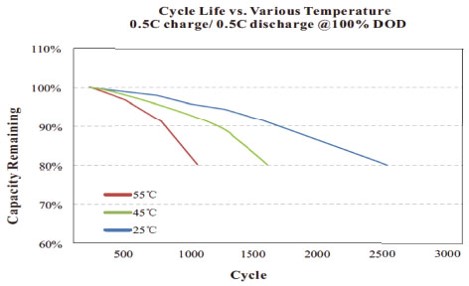1) Temperature is the key factor to impact cycle life
2) Both low temperature and high temperature can impact cycle life
3) Charging at below 0℃ may be the most significant cycle life impact
4) Charging at high than 45℃ may be risk

1) Whether or not LiFePO4 battery is fully charged should be determined by detecting charging voltage and the charging current.
2) If the charging voltage has reached (3.60~3.65)V*N (Number of cells in series), and transfer to constant voltage charging, till to charging current is down to 0.05C.
1) For long term cycle use, we’d recommend 0.2C charging current for standard charge.
2) For fast charge, we’d recommend 0.5C ~ 1.0C charging current accordance with
3) When charging battery at varieties environment temperature, we recommend an appropriate charging current vs. the environment temperature as below: a) 0~5℃: ≤0.2C b) 5~15℃: ≤0.5C c)15~25℃: ≤1.0C d) 25~35℃: ≤0.8C e) 35~45℃: ≤0.5C
1) State of charge: 50%
2) Relative humidity: 45~85% H.R.
3) Temperature: * at -5~25℃ for 1 years and recharge to 3.3V (SOC 50%) to maintain the battery * at -5~35℃ for 3 months and recharge to 3.3V (SOC 50%) to maintain the battery * at -20~45℃ for 1 months and recharge to 3.3V (SOC 50%) to maintain the battery
4) A temperature of 60℃ or higher and extremely high relative humidity will accelerate the deterioration of battery performance.
5) A higher battery voltage it means higher SOC for long term storage will accelerate the deterioration of capacity.
6) A lower battery voltage it means lower SOC for long term storage will lead to over discharge, cells imbalance due to self-discharge and BMS consumption
1) Safety: LiFePO4 is the safest of the mainstream li-ion battery types.
2) High energy density: Light weight,50~60% less weight than lead acid equivalent.
3) Long cycle life: Up to 10X longer cycle life than lead-acid equivalent.
4) Fast charge: Fast charge within 3hours.
5) Wide operating temperature range: From -25℃ ~ 60℃
6) Deep cycle discharge: DOD up to 95% at above 1C
7) Constant power: Constant power is available throughout discharge, voltage would not decline like lead acid.
8) Maintenance free: Maintenance free, no watering, plug and play, doesn’t like lead acid batteries.
9) Low self-discharge: It is less than 3% self-discharge per month stored at ambient temperature 25℃ and humidity 25~85%RH.
10) Green energy: Does not contain any polluting substances such as cadmium, lead, mercury, eco-friendly.
Lithium trolling motor batteries are typically safe for watercraft use when maintained properly. These batteries are a top choice for trolling motor who need reliable power with high storage capacity, quick charging, and versatile performance in various conditions. Compared to lead-acid batteries, lithium batteries provide more flexible installation options and are less prone to damage or leaks during turbulent sailing.
Lithium-Ion batteries are generally safe when used and maintained properly. However, safety concerns arise due to their flammable electrolyte and high energy density. Our LiFePO4 batteries offer enhanced safety through a robust chemical and mechanical design that is non-flammable and non-hazardous.
These batteries are built to endure challenging conditions, including freezing temperatures, high heat, and rough terrain. They are designed to resist hazardous events like collisions or short-circuiting without exploding or catching fire, significantly reducing the risk of accidents.
If you're looking for a lithium battery that's safe for unstable or hazardous environments, LiFePO4 is a top choice. They're also environmentally friendly, as they are non-toxic, non-contaminating, and don't contain rare earth metals. This makes them a safer option for both users and the environment.
A solar tracker battery typically works in conjunction with a solar tracking system, which adjusts the orientation of solar panels throughout the day to maximize their exposure to sunlight.
Solar Panels: Solar panels are mounted on a solar tracker, which moves them to track the sun's position throughout the day.
Energy Generation: As the solar panels track the sun, they generate electricity from sunlight.
Energy Storage: The electricity generated by the solar panels is then directed to charge the solar tracker battery. This battery serves as an energy storage system, storing excess electricity generated during peak sunlight hours.
Usage and Distribution: The stored energy in the battery can be used later when sunlight is not available, such as during the night or during periods of low sunlight. It can power various applications or be connected to the electrical grid to supply power to homes, businesses, or other facilities.
Optimizing Efficiency: By storing excess energy during peak sunlight hours, the solar tracker battery helps optimize energy usage and ensures a consistent power supply, even when solar panel